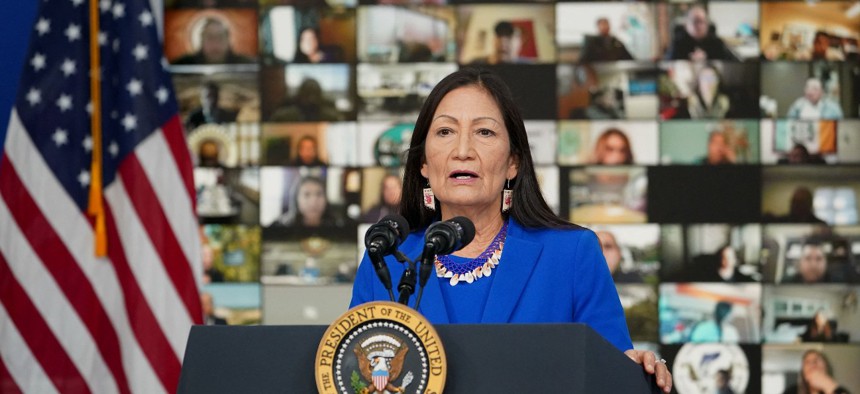
MANDEL NGAN/Getty Images
A New Regulation Will Bolster Procurement for Tribal Businesses
The Interior Department’s final rule advances the president’s executive order on equity.
A final rule published on Friday will work to increase federal procurement opportunities for Tribal owned and operated businesses.
The Interior Department started this rulemaking process in October 2021 in order to further President Biden’s early executive order on advancing racial equity and supporting underserved communities through actions by the federal government. The rule updates the Buy Indian Act, first enacted in 1910, which allows the department to give funding and procurement preferences to Indian owned or operated businesses.
“These regulations will promote economic opportunities in and near Tribal communities for Native-owned businesses,” Bryan Newland, assistant secretary for Indian Affairs, stated in a press release on Thursday. “This is a key part of our goal to make sure that Indian people have the opportunity to live safe, healthy and fulfilling lives in their Tribal communities.”
The final rule, published in the Federal Register on Friday, will take effect in 30 days. It eliminates barriers for Indian Economic Enterprises competing on certain construction contracts; expands their ability to subcontract for construction work (which is consistent with other socio-economic set-aside programs); gives more preferences to Indian Economic Enterprises, updates the process and thresholds for deviations from the Buy Indian Act and clarifies applicability of the act.
The Buy Indian Act's requirements apply to the bureaus and offices under the Assistant Secretary for Indian Affairs, which includes the Bureau of Indian Affairs, Bureau of Indian Education, and Bureau of Trust Funds Administration. The act's provisions are optional for the Interior Department's other bureaus, the department told Government Executive on Friday.
Indian Economic Enterprises are businesses that are owned by one or more Indians or Indian tribes that are established for the purpose of profit given that the combined Indian or tribal ownership is no less than 51%.
“In fiscal year 2021, nearly $280 million in spending went to Native-owned businesses, which represents 59% of all Indian Affairs purchasing power,” which is “a significant increase from fiscal year 2018, when Buy Indian Act purchasing was $85.4 million,” according to the department. “Over the next several years, the new regulations are expected to result in up to 65% of Indian Affairs purchases being set aside for Native-owned businesses, with up to $325 million flowing to Indian Country annually.”
The final rule also aligns with the department's January update to the Health and Human Services Department’s Indian Health Service (the other agency the act applies to), as previously reported by Government Executive, and supports implementation of the 2020 Indian Community Economic Enhancement Act.
“The Buy Indian Act itself is brief and contains little detail,” the Government Accountability Office stated in a 2015 report. “The key to implementing the act is in both agencies’ regulation” as both HHS and Interior “have broad discretion over whether and how to utilize [it].”
“Implementation of the Buy Indian Act has been an evolutionary process,” Wizipan Garriott, principal deputy assistant secretary for Indian Affairs, said in his prepared statement for a Senate hearing last month.
Update: This story has been updated with information from the Interior Department at 5:02p.m.







